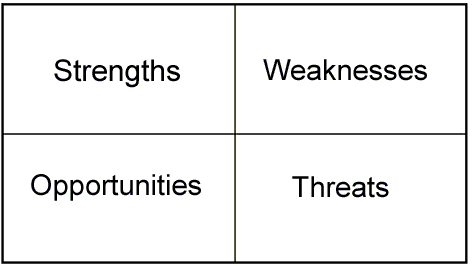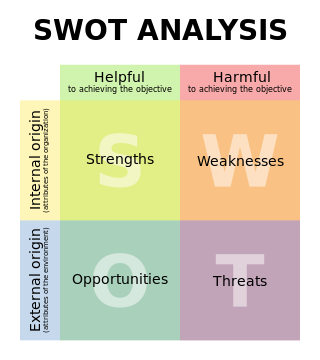SWOT analysis
| Line 49: | Line 49: | ||
[[File:swot-matrix.png]] | [[File:swot-matrix.png]] | ||
| − | + | ||
| + | ==Internal and external factors== | ||
| + | The strengths and weaknesses are, as mentioned, not only factors regarding the present, they are also to be found ''within'' the system subject to the SWOT analysis. Corresponding are the opportunities and threats not only factors regarding the future, they are also to be found ''outside'' the system subject to the SWOT analysis. This is to differentiate between factors the system is in control of, such as finance and operations, and factors the system is not in control of such as economic and political factors. <ref>[''Swot Methodology: A State-of-the-Art Review for the Past, A Framework for the Future''] ''http://www.tandfonline.com/doi/pdf/10.3846/16111699.2011.555358'' </ref> | ||
| + | |||
| + | |||
| + | can be found in the question: "how can systems utilise | ||
-Den hvor indre og ydre faktorer er taget med og forklar at pointen er at indre faktorer har man kontrol over og ydre har man ikke. | -Den hvor indre og ydre faktorer er taget med og forklar at pointen er at indre faktorer har man kontrol over og ydre har man ikke. | ||
Revision as of 16:08, 23 November 2014
Contents |
Abstract
This article will discuss different approaches when making a SWOT analysis.
Introduction
Skriv hvorfor det er relevant for projektledelse, programledelse og portefølgeledelse
The SWOT analysis is a tool that provides a basic framework for situation analysis. It generates lists or inventories of strengths, weaknesses, opportunities and threats which can be used when generating strategies. [2] There is no single guide or manual on how to perform a SWOT analysis - on the contrary many papers, books and articles have been issued describing, criticising and expanding on the usage of SWOT analysis combining it with other analytical approaches.
The SWOT analysis has a very simple structure which allows it to be performed on many levels of depth and accuracy. This attribute is also the basis upon which it it has been greatly debated and optimisingly treated. If the purpose of performing the SWOT analysis is to derive strategies for businesses or projects, a worse-case scenario could be "[...] a poorly structured, very general, hastily conducted exercise that produces unverified, vague and inconsistent inventories of factors[...]" [3].
This article seeks to present the reader with a guide on how to perform a conventional SWOT analysis as well as presenting a variant called the "TOWS matrix" - a variant of the SWOT analysis which utilises the inventory of SWOTs in a more systematic way than the conventional. The SWOT analysis will be presented on three different levels of depth and accuracy beginning on the lowest to motivate the points on which it has been criticised.
The history of SWOT
Although there is no single inventor/author of the SWOT analysis, early versions are developed in Harvard Business School by George Albert Smith Jr. and C Roland Christiensen in the 1950s and 1960s [4]. The four factors that later became the Strengths, Weaknesses, Opportunities and Threats (SWOTs) were then called "opportunities" "risks" "environment" "problems of other industries". Another version was developed at Stanford University by Albert Humphrey which was based upon factors we know as SWOT today. The factors, represented by the acronym SOFT, were then: “What is good in the present is SATISFACTORY, good in the future is an OPPORTUNITY; bad in the present is a FAULT and bad in the future is a THREAT.” [5]
SWOT analysis
The SWOT analysis is usually presented in a 2X2 matrix which generates four boxes of inventories - one for strengths, one for weaknesses, one for opportunities and one for threats, see figure 1
Figure 1
The simplicity of the matrix also resembles the most criticisable approach to conducting the analysis. The analysis can be carried out in three steps[6]:
Step 1 Gather information about the present. These are the strengths and weaknesses.
Step 2 Think of what might be in the future. These are the weaknesses and threats.
Step 3 Review the SWOT matrix with the aim of creating an action plan that involves the four areas like this:
Strengths - need to be maintained, built upon or leveraged
Weaknesses - need to be remedied, changed or stopped
Opportunities - need to be prioritized, captured, built on and optimized
Threats - need to be countered or minimized and managed
Another SWOT matrix takes into account the fact that the strengths and weaknesses are internal factors as well as the opportunities and threats are external factors. See figure 2. This indicates that there are more points to pay attention to implied when conducting a SWOT analysis. The following sections will summarise and elaborate on these implications for conducting a useful SWOT analysis.
Internal and external factors
The strengths and weaknesses are, as mentioned, not only factors regarding the present, they are also to be found within the system subject to the SWOT analysis. Corresponding are the opportunities and threats not only factors regarding the future, they are also to be found outside the system subject to the SWOT analysis. This is to differentiate between factors the system is in control of, such as finance and operations, and factors the system is not in control of such as economic and political factors. [7]
can be found in the question: "how can systems utilise
-Den hvor indre og ydre faktorer er taget med og forklar at pointen er at indre faktorer har man kontrol over og ydre har man ikke. -Den med "beneficial" og "inbeneficial". Den ved jeg ikke helt hvad jeg skal med men det kommer jeg til.
Application example
References
- ↑ [link/title] Name of link
- ↑ [SWOT does not have to be recalled - it needs to be enhanced] http://www.westga.edu/~bquest/2000/swot1.html
- ↑ [SWOT does not have to be recalled - it needs to be enhanced] http://www.westga.edu/~bquest/2000/swot1.html
- ↑ [History of SWOT Analysis] http://www.marketingteacher.com/history-of-swot-analysis/
- ↑ [SWOT analysis (TOWS matrix) Made Simple] https://rapidbi.com/swotanalysis/
- ↑ [SWOT analysis (TOWS matrix) Made Simple] https://rapidbi.com/swotanalysis/
- ↑ [Swot Methodology: A State-of-the-Art Review for the Past, A Framework for the Future] http://www.tandfonline.com/doi/pdf/10.3846/16111699.2011.555358

